Have you ever considered visiting Ethiopia? If the answer is yes, you should! Here are 10 places to visit in Ethiopia if it’s your first time visiting, adding up to the ideal 2 weeks Ethiopia itinerary!
I can’t deny Ethiopia was on my wish list of places to visit for a very long time, after having seen pictures of Lalibela during Coptic Christmas taken by one of my mum’s friends over a decade ago.
However, there was always a little problem. If you look at Ethiopia on the map, right on the edge of the Horn of Africa, you’ll immediately notice that the country is huge. There are so many places to visit in Ethiopia, that most Ethiopia itineraries either focus either on the northern, or southern part of the country.
So, what to choose! That was my dilemma. Shall I start with the north, and visit the UNESCO-listed rock-hewn churches of Lalibela, hike the rugged landscapes of the Simien Mountains, and immerse myself in the primal beauty of the Danakil Depression?
Or shall we opt for the south, visit the Omo Valley and its dozens of ethnic groups, each with their own separate traditions and rituals, then maybe head to the Holy City of Harar?
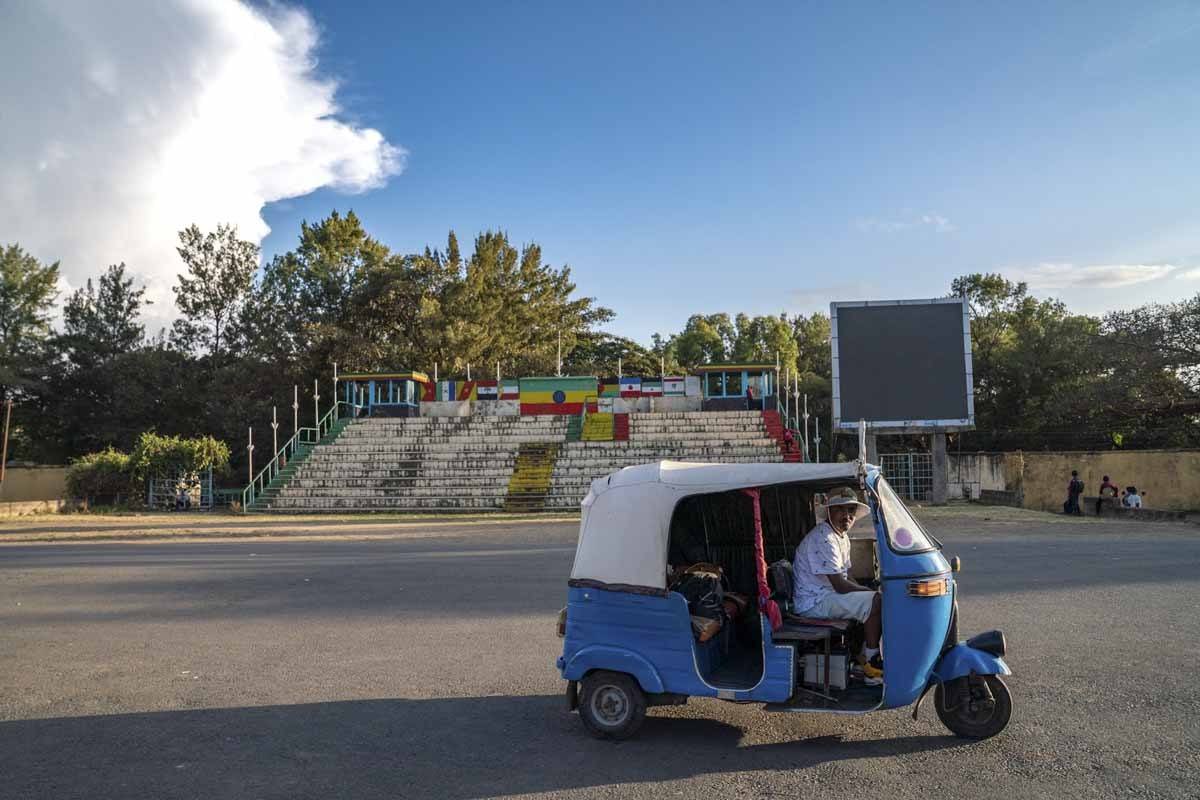
After researching, I made up my mind. With only two weeks to spare, I recommend visiting Northern Ethiopia. First of all, for practical reasons – there are frequent domestic flights between cities with Ethiopian Airlines, roads are in far better conditions, and distances aren’t as vast.
Second – and most importantly – because ‘ethno tours’ of the Omo Valley, the highlight of Southern Ethiopia, are said to resemble human zoos rather than meaningful cultural encounters. This is obviously not something we want to support – so, Northern Ethiopia it is!
Here are 10 amazing places to visit on your first trip to Ethiopia. All of them were part of the two week Ethiopia itinerary I followed during my time in the country last November – except one. Let’s have a look!
10 Amazing Places to Visit In Ethiopia
1) Addis Ababa – 2 Days
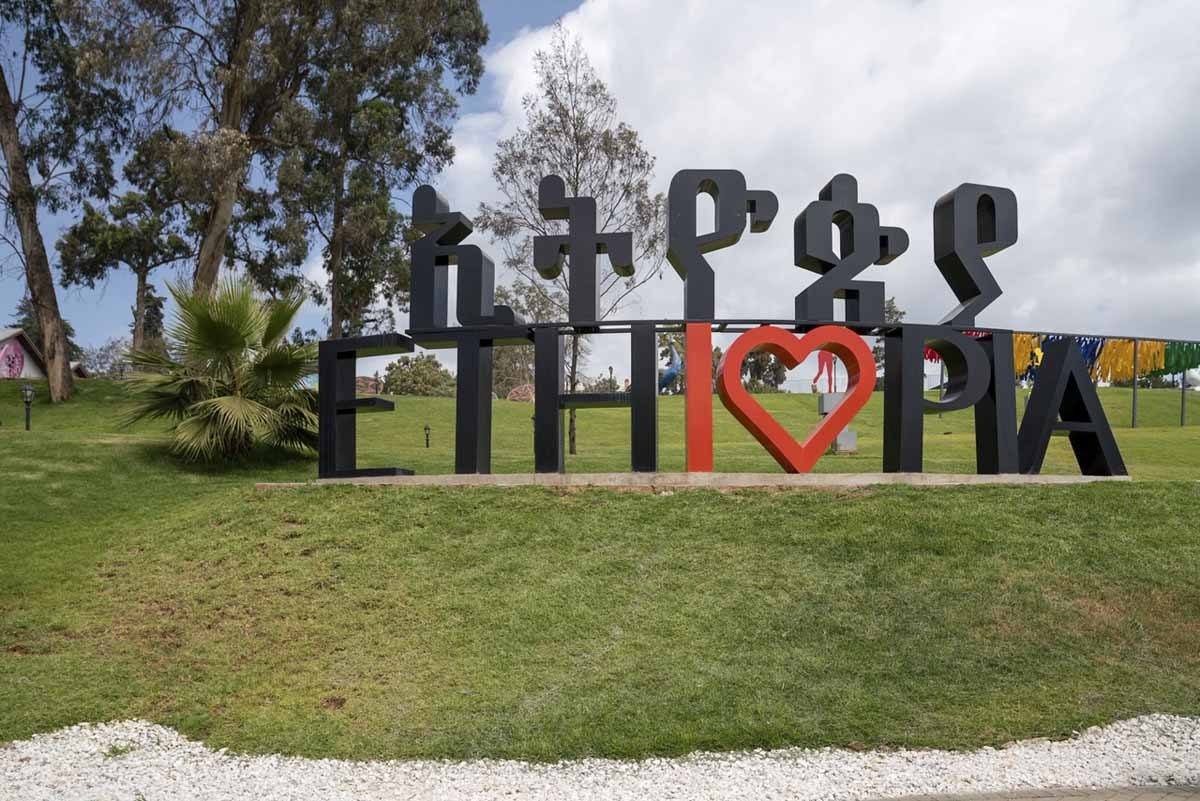
If you’re flying into Ethiopia, chances are you’ll be starting your trip in Addis Ababa, the capital. The name ‘Addis Ababa’ means ‘new flower’, but don’t be fooled by ideas of a city filled with green spaces – Addis is huge and dusty, traffic is a nightmare, and getting around takes ages.
Many people can’t wait to get out of the city, but I would recommend dedicating at least a couple of days to get used to the altitude. Most of the places I visited and included in this Ethiopia itinerary are over 2500 meters above sea level, so it’s better to take it easy for a couple of days.
Addis also belongs in this list of places to visit in Ethiopia because there are many cool things to see and do in Addis Ababa – first and foremost, you can’t miss the National Museum of Ethiopia.
It only costs 10 birr to enter (approx 30 euro cent!) and it displays a number of skeletons found in the Rift Valley, including the famous Lucy, the most complete skeleton ever discovered of an early human ancestor.
Another sight worth checking out is the recently-opened Unity Park, a complex including museums and exhibitions about Ethiopian history in the former Grand Imperial Palace, plus a 15-acre landscaped park with pavilions dedicated to each of Ethiopia’s 11 regional states.
Tickets for foreigners cost between $20 and $50 USD – which may sound like a lot, but there’s a lot to see!
If you are a keen runner, we recommend planning your Ethiopia visit to coincide with the yearly Great Ethiopian Run, a 10 km race taking place every year in November.
Tens of thousands of people participate each year, making it the biggest and liveliest race in Africa and the most sought after event in the country’s calendar! What makes the race more special is that part of the funds raised goes to raising awareness of important social causes, like health and education. The focus of the 2019 race was women’s issues and promoting gender equality.
Here are 13 reasons to do the Great Ethiopian Run to find out more about this unmissable event in Addis Ababa!
Where to Stay in Addis Ababa
Hyatt Regency – one of the best hotels in town, and definitely the best in terms of location since it’s right on Meskel Square, where the race starts and ends. Rooms are spacious and comfortable, and the hotel also has an outdoor pool, gym, coffee shop and excellent Middle Eastern restaurant.
Getting to Addis Ababa
Ethiopian Airlines connects Addis Ababa’s Bole airport to most major cities worldwide.
We recommend flying into Ethiopia with Ethiopian Airlines for a very good reasons – you’ll get up to 50% off on domestic flights, meaning that reaching all these places to visit in Ethiopia will be easy and affordable!
2) Sululta – 1 Day
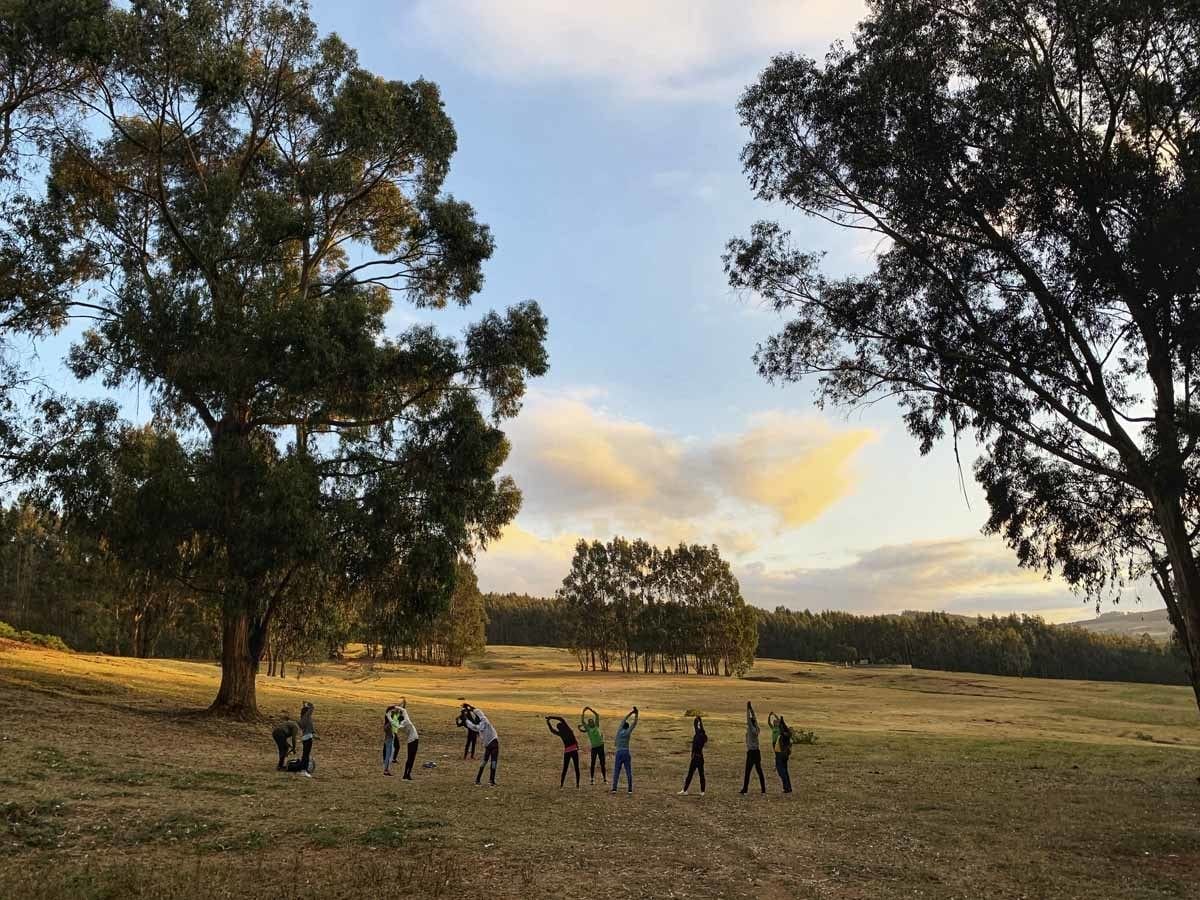
Su-what? I’m pretty sure you’ve never heard of this place – I certainly hadn’t, until we got to stay at Yaya Village in Sululta, a high-altitude training centre and resort perfect for athletes visiting Ethiopia, owned by running legend Haile Gebrselassie.
If you’re visiting Addis Ababa for the Great Ethiopian Run, we definitely recommend heading to Yaya Village for a night or two. Sululta is hidden away in the highlands surrounding Addis – it’s a great place to escape the chaos, and get some training in before the race.
There’s a gym, a small spa, an on-site track and even a Spartan-style obstacle course, plus a nice local restaurant!
If you’re not in Ethiopia for the race, Yaya Village is still a nice place to check out – otherwise feel free to ‘use’ this extra day to explore places like Gondar or Lalibela at ease!
Getting to Sululta from Addis
Sululta is only 15 km away from Addis Ababa. However, traffic is hectic so travel time ranges between half an hour to two hours or more. The best way to reach Yaya Village is by car, but make sure you pre-arrange that, as taxi drivers on the street are likely to overcharge you.
3) Lalibela – 1/2 Days
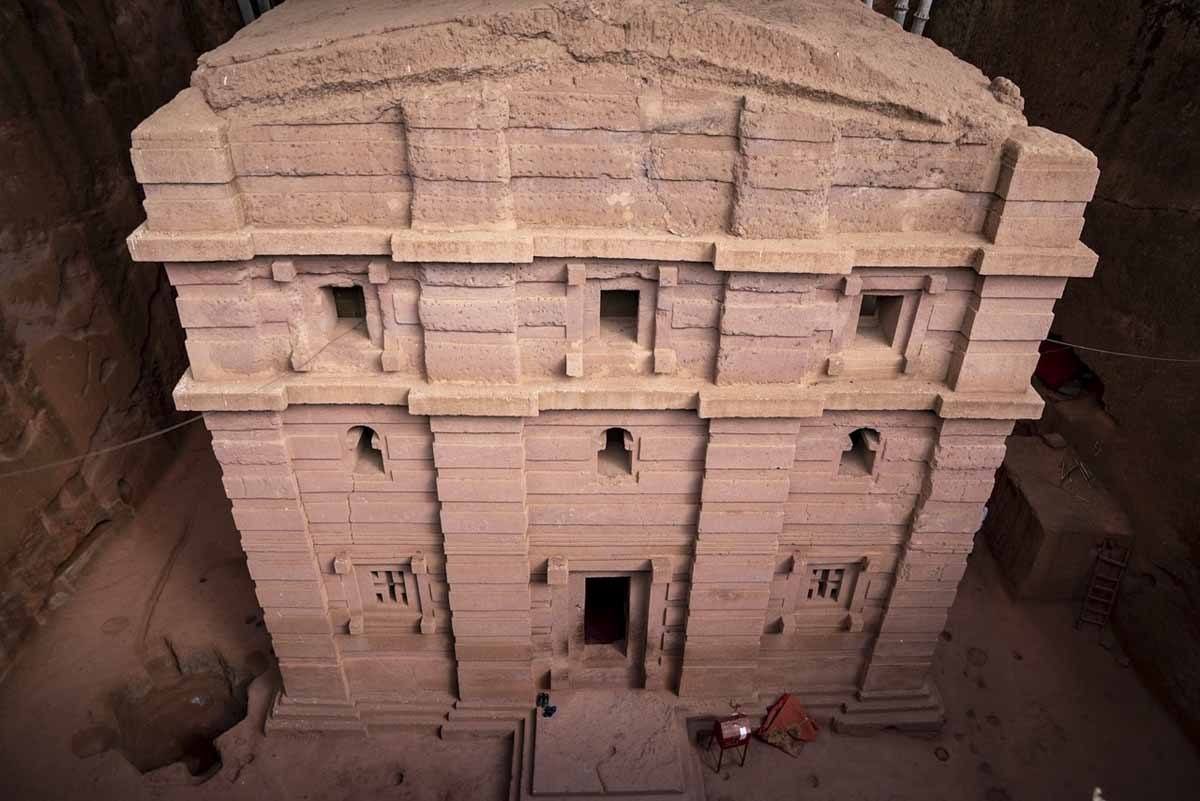
The rock-hewn churches of Lalibela are probably the most famous place to visit in Ethiopia, found on all guidebook covers and tourism posters. I’m of the firm belief you shouldn’t miss Lalibela in your Ethiopia itinerary – the place is truly out of this world.
Even though most pictures of Lalibela are of cross-shaped St. George’s church, the complex includes 10 more churches, all carved in the rock.
The Lalibela churches date back to the 13th century – their construction was ordered by their namesake, King Lalibela, to provide a safe place of worship for Coptic Christians, threatened by frequent Muslim invasions from the north.
The 11 churches were carved in a record 23 years – that’s because angels helped, our guide said.
The ticket to access Lalibela is quite pricey at $50 USD, but it’s valid for 5 days. We recommend a minimum of 2 days to see all the 11 churches without going crazy, and highly recommend hiring a guide.
Getting to Lalibela from Addis
The bus from Addis Ababa takes a whopping two days! Luckily there are frequent Ethiopian Airlines flights, taking about one hour. The airport is about 30 km away from the churches.
Where to Stay and Eat in Lalibela
Tukul Village – a lovely midrange hotel with spacious rooms in round-shaped buildings with floor-to-ceiling bay windows.
Jerusalem Hotel – known for its stunning views over the valley!
Ben Abeba Restaurant – worth visiting for the crazy-looking building (really, you HAVE to see it), for the sunset views and tasty food, including shepherd’s pie and scotch eggs!
4) Bahir Dar – 1/2 Days
This was the only place on this list I didn’t actually visit, but decided to include it anyway because it was mentioned as a favourite place to visit in Ethiopia by many people I met in Ethiopia.
Bahir Dar is located on the southern shore of Lake Tana. People I spoke to said it’s a relaxed town by Ethiopian standards, where it’s fun to wander around and sit down for an Ethiopian coffee or a juice to watch the world go by.
The main attractions in Bahir Dar are not in the town itself, but just outside – the stunning monasteries of Lake Tana, which can be accessed with a boat tour, and the Blue Nile waterfalls. I’ll definitely be adding Bahir Dar to my list of places to visit in Ethiopia next time!
Getting to Bahir Dar from Lalibela
Once again, flying Ethiopian Airlines is the easiest way! There are sometimes direct flights between Lalibela and Gondar, otherwise you’ll have to connect flights in Addis.
Where to Stay in Bahir Dar
Manuhie Backpackers Lodge – came recommended by a couple of people I met in Ethiopia as a good place to stay with a nice, easy going vibe. The owner can help arrange boat tours and car transfers to other places to visit in Ethiopia.
5) Gondar – 1 Day
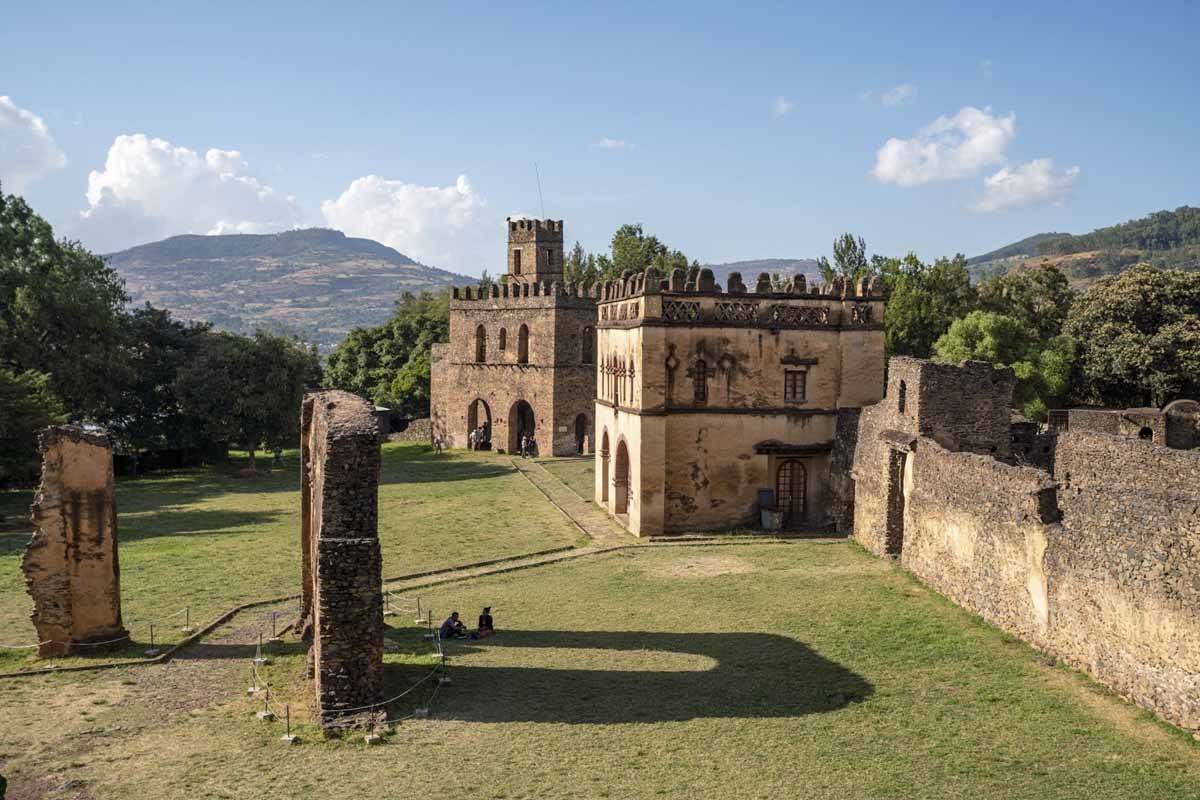
Oh Gondar! This was my favourite surprise of this two week Ethiopia itinerary, a place I visited with absolutely no expectations, but I really enjoyed even though I only spent a day there.
There’s a lot to see and do in Gondar, but sights are really spread out, so it makes sense to hire a tuk tuk (known as bajaj in Ethiopia) to take you around. This shouldn’t cost more than 250 birr for about 3/4 hours, covering the following three sights.
The main sight in Gondar is Fasil Ghebbi Castle, built in the 17th century by Emperor Fasilides. It’s not one single castle but a complex of buildings set around a park, including some concrete and iron cages where lions were kept until as late as 1990!
Entrance ticket to Fasil Ghebbi Castle is 200 birr and also includes access to Fasilides Bath, a large pool surrounded by trees with a three-storied building sitting on columns over the waterline, believed to be the emperor’s holiday home. The pool is usually empty, filled just once a year to celebrate Epiphany.
The final place in Gondar usually visited on tuk tuk tours is the stunning Debre Birhan Church. It may not look like much from the outside, but as soon as you enter your jaw will drop – the ceiling beams are decorated with hundreds of angels, and on the walls you’ll see graphic (but somehow cool in a pop sense) depictions of hell and demons.
Bonus tip – when sunset comes, offer your tuk tuk driver an extra 100 or so birr to whisk you to Goha Hotel, then head to the terrace for killer views over Gondar!
Getting to Gondar
From Lalibela or Addis, the best option is flying. Bahir Dar is only 173 km away, taking about 3/4 hours by car. There are no direct buses but you should be able to find a driver easily.
Where to Stay and Eat in Gondar
Gondar Backpackers – new hostel run by an Israeli lady and her Ethiopian husband. Both dorms and common spaces are comfortable, there’s a shared kitchen and laundry is great value. The tuk tuk driver affiliated with the hostel, called Havtu, is really wonderful.
Goha Hotel – good option for those with bigger budgets, with a hilltop position and nice views.
Mami Shiro – friendly locals-only place not far from Gondar University. It’s a bit hard to find as the sign outside is only in Amharic, but passer-bys will help. The shiro tegamino (spicy puree made with ground beans) was excellent.
Four Sisters – popular tourist restaurant in the centre of Gondar, serving really good Ethiopian and international fare. The fasting platter (vegan) is really tasty.
6) Simien Mountains – 2 Days
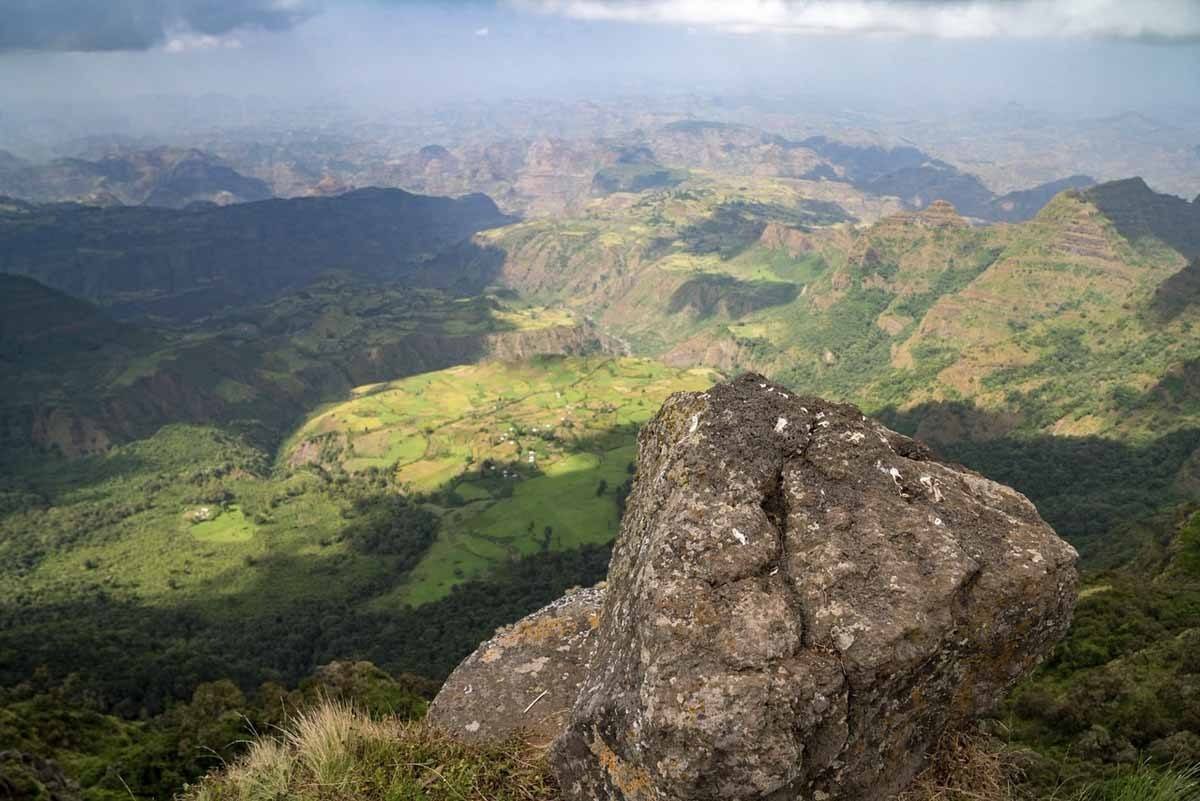
There’s also one more reason to visit Gondar – it’s the starting point for most hiking trips around the Simien Mountains, a national park about 3 hours north. The Simien Mountains are worth visiting for their dramatic landscapes, with canyon, pinnacles and plateaus overlooking wide valleys.
Hiking is the best way to discover the Simien Mountains. Trips range from a minimum of two to a maximum of 7 days – longer trips include the climb to the summit of Ras Dejen, the highest mountain in Ethiopia.
2 and 3 day trips are the most common, including stops at several viewpoints and at Jinbar Waterfall – which reminded me of Kaieteur Falls in Guyana! You’ll also get to see gelada baboons, a species endemic to the Ethiopian Highlands.

All Simien Mountains trips start with a stop in Debark, a town on the edge of the national park, where you’ll meet your guide and armed scout – who are required by law to be with you at all times.
Guides and scouts are all Simien locals, they belong to a cooperative and work on a rotation basis – so there’s no guarantee you’ll be getting a specific guide, or a better guide if you pay more.
Accommodation during hikes across the Simien Mountain is either in tents or community lodges, and you’ll be eating food freshly cooked by local chefs in camp kitchens – it was one of the best meals I had in Ethiopia!
7) Axum – 1 Day
Next up in our list of places to visit in Ethiopia is Axum (Aksum), a town with a long and glorious past, famous for having been home to the legendary Queen of Sheba.
Axum is also the starting point for trips to the Tigray Churches, often visited en route to Mekele.
If you have time, Axum has enough sights to fill a day or two of sightseeing. The first place to visit should definitely be the St. Mary of Zion Church Complex, the most important church in the Ethiopian Orthodox faith.
The Ark of the Covenant is said to be housed in a chapel within the complex, even though no one (not even the official guardian!) is allowed to look at it.
The complex includes several buildings – the Cathedral of our Lady Mary of Zion, first built in the 4th century and off-limits to women, the New Church of St. Mary of Zion, built by Haile Selassie in the 1960s for women to worship, and the Chapel of the Tablet, off-limits to everyone. Entrance to the complex is 300 birr.
The second unmissable place to visit in Axum is the Stelae Field, home to a number of stelae including the famous Obelisk of Axum. It’s possible to walk around the field and even visit some of the underground burial chambers marked by the stelae.
You can access the Stelae Field with a 300 birr ticket allowing you to enter all archaeological sites in and around Axum, including Queen Sheba’s Palace, Queen Sheba’s Bath, King Kaleb and King Bazen’s Tomb, and the Ezana Stone – a kind of ‘Ethiopian Rosetta Stone’ inscribed in three languages (Ge’ez, Sabaean, and Ancient Greek).
Just one word of warning – Axum is full of touts who will try to pressure you into joining overpriced guided tours, quoting as high as €150 for a full day tour.
You can easily walk to all destinations mentioned in this section (minus Queen Sheba’s Palace) from the city centre. If you wish to hire a guide, it shouldn’t cost more than 600 birr for the day.
Getting to Axum from Gondar
There are Ethiopian Airlines flights between Gondar and Axum (sometimes with a stopover in Lalibela), and between Axum and Addis. Otherwise, if you’re on a longer tour around the Simien Mountains (3+ days) you could arrange with your operator to be dropped off in Axum.
Where to Stay and Eat in Axum
Armah Hotel – a Chinese-built business style hotel, easy to book online and getting good reviews. Breakfast is included and very good.
Lucy Traditional Restaurant – Ethiopian restaurant also serving (overpriced) international fare. The fasting platter is very good.
Kuda Juice and Pizzeria – nice pizza, burgers, salad and fresh juices.
8) Tigray – 1 Day
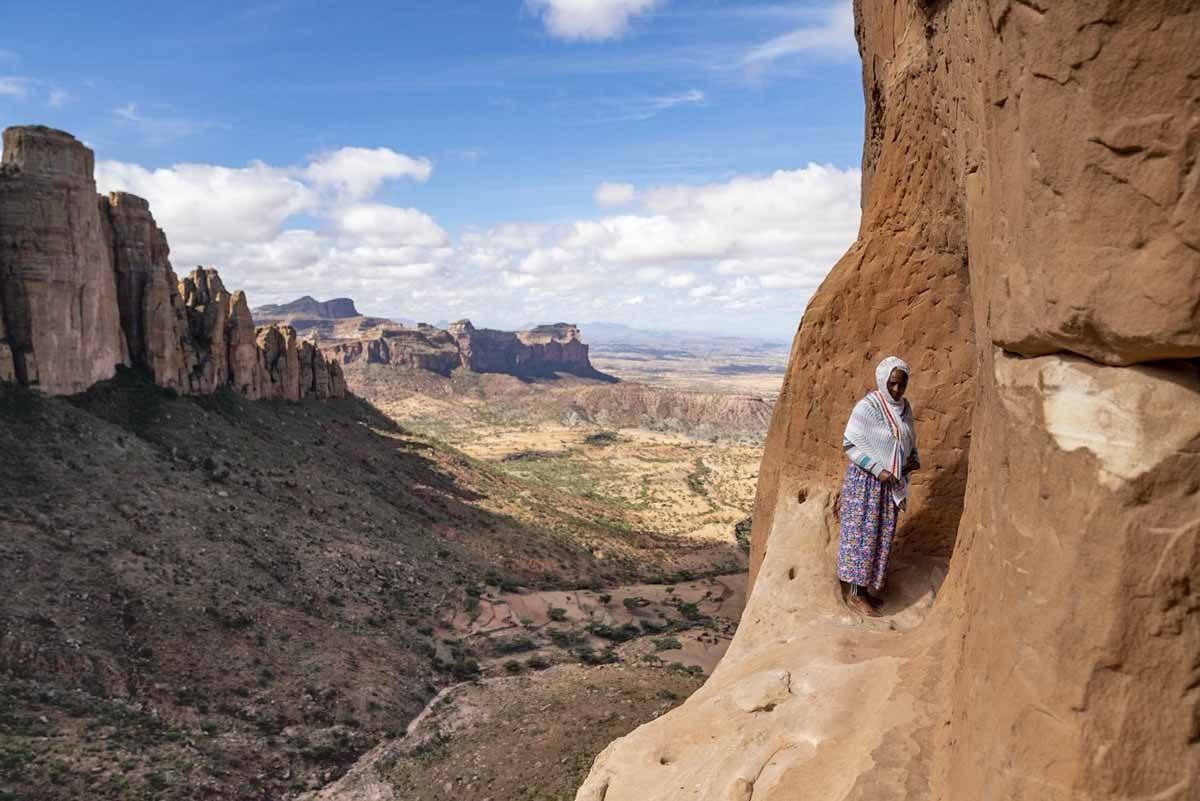
Axum is the second-largest city in the Tigray region, known for its rock churches. It’s common to visit the Tigray Churches as you travel between Axum and Mekele, and you can opt for one or two day tours.
On a one day tour, you’ll be visiting the three most famous Tigray churches in the Gheralta mountains – Abuna Yemata Guh, carved in the rock at the top of a pinnacle, and nearby Maryam and Daniel Korkor.
Abuna Yemata Guh is a truly unique place, not for the faint of heart – you can only access it by climbing a rock wall with bare hands and feet, and then walking on a meter-wide ledge with a 200-m vertical drop to the side. Inside, you’ll see spectacular paintings dating back to the 6th century AD.
The two-day tour also includes visits to Debre Damo Monastery, also only accessible by rock-climbing (and off-limits to women!) and the Temple of Yeha, the oldest building in Ethiopia, dating back to the 7th century BC.
I recommend choosing the 1-day tour, as I wasn’t really impressed with Yeha, while the Tigray churches of Gheralta really should be part of your Ethiopia itinerary!
Where to Stay in the Tigray
If you opt for the two-day tour of the Tigray, you’ll be spending a night in Hawzien, a dusty city not far from the Gheralta mountains. Here are two options!
-Gheralta Lodge – an upmarket lodge just outside Hawzien, getting rave reviews!
-Vision Hotel – a friendly budget hotel with home-cooked food.
9) Danakil Depression – 3 Days
If you failed to add the Danakil Depression to your Ethiopia itinerary, go back and add it right now! This place is truly out of this world and definitely deserves to be on your list of places to visit in Ethiopia.
The Danakil Depression is one of the harshest, most inhospitable places in the world. It’s approximately 125 meters below sea level, and unbearably hot year round – in summer, temperatures routinely exceed 45°C.
The region is home to the Afar people, often in conflict with the central government. There have been incidents in the past – a German tourist was killed in 2017, so always check locally before committing to a tour, and be ready to change your plans.
A three-day Danakil Depression tour will include an overnight stay near Erta Ale Volcano, with a night-hike to see lava flowing, a visit to Lake Afrera where you can float just like in the Dead Sea, and finally a hike around Dallol, famous for its colourful hot springs and rock formations.
A 3-day tour of the Danakil Depression cost between $300 and $400 and include accommodation, food, drinking water and all fees. Don’t expect luxury – you’ll be sleeping on mattresses on the ground in the desert or in basic guesthouses.
10) Mekele – 1 Day
After your Danakil tour, you’ll be dropped off in Mekele. It’s a large city, the economic and political centre of northern Ethiopia, but it doesn’t have much to offer in terms of sights.
The main (only?!) thing to see is the Atse Yohannes IV Museum, recently reopened in the palace of former emperor Yohannes IV. Exhibits include Tigrayan crafts, religious and royal paraphernalia, and the Emperor’s bed and throne.
Spend the remainder of your day in Mekele resting after the Danakil trip (you’ll need it!) and shopping in the extensive market, where you can pick up souvenirs for friends back home.
Getting to Mekele from Addis
Once again, you can fly to Addis with Ethiopian Airlines. If you’re visiting the Tigray or Danakil, your tour will end in Mekele.
Where to Stay in Mekele
–Mekelle Hotel – a modern-looking, Chinese-style hotel with clean rooms and great service.
–Parrot Guesthouse – budget friendly accommodation with rooms set around a leafy garden.
Important Things to Know About Ethiopia
When to Visit Ethiopia
The best time to visit Ethiopia is between October and June, coinciding with the dry season. We visited in November and conditions were ideal – we had little rain and temperatures weren’t unbearably hot, except in the Danakil where it’s always hot.
You can also time your visit to witness religious festivals, such as Coptic Christmas at Lalibela (January 7th) or Timkat in Gondar (January 20th), when the pool of Fasilides Bath is filled.
Visa Requirements
You’ll need a visa to enter Ethiopia. People from most countries can get a visa on arrival at Addis Ababa Bole Airport, at a cost of $50 USD – no other currencies are accepted.
You can also apply for an eVisa before your trip, for an extra $2 handling fee. Make sure you use the official site, and not one of many copycats charging high fees!
Tipping Etiquette
Tips are expected in Ethiopia, especially when it comes to guiding services. We tipped our guides, scouts and cooks between 100 and 200 birr per day, but only when we were happy of their service.
Don’t forget that tips are at your discretion and only to be given when you’re happy with the service, so don’t feel the need to tip bad guides, or let them dictate how much you should give.
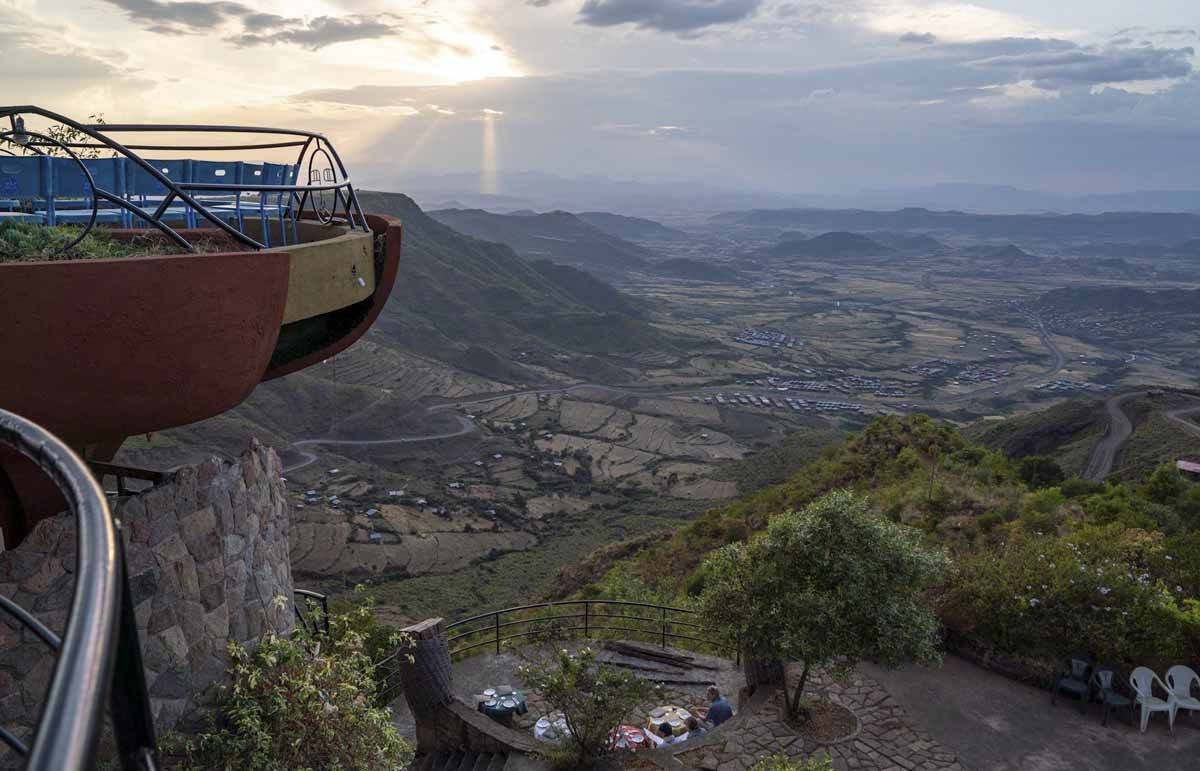
Ethiopian Food
Ethiopian food is a ‘love it or hate it’ affair. I was convinced I would fall into the ‘love it’ category, but after two weeks of it non-stop… I was a bit sick of it.
The staple is injera, a pancake-like bread made with fermented teff, a grain native to Ethiopia and rich in vitamins and amino acids. Injera is laid out on a communal platter and topped with a varieties of stews and curries, either meat or vegetable-based.
You eat with your hands from the platter, dabbing at the sauces and stews with more injera, served separately and rolled out into ‘tubes’. Many people don’t like the peculiar taste of injera – since the grain is fermented, it has a distinctive acidic taste.
Good news if you’re a vegetarian or vegan! Ethiopian Orthodox Christian abstain from eating all animal products twice a week, and during specific times of the liturgical year. For this reason, ‘fasting food’ is on offer everywhere. It’s all vegan, and delicious!
Responsible Travel Tips
Please refrain from giving ANYTHING to children in the street. Not just money – please, don’t give them sweets, pens or anything else. ‘But surely just one, it won’t make a difference!’ – no. Please don’t.
Ethiopia has done great progress in terms of sustainable development, establishing the first waste-to-energy plant on the outskirts of Addis Ababa – incinerating over 80% of the city’s waste while providing electricity for 30% of the population.
You’ll see next to no litter anywhere in the country – except for the Danakil Depression, which is a plastic bottle wasteland. There’s no water in the Danakil, so even the usual alternatives like Steripens or filter water bottles won’t work here.
You’ll have to drink from plastic bottles, so please make sure you take them all back with you, and possibly also pick up some extra ones lying around. Every little helps!
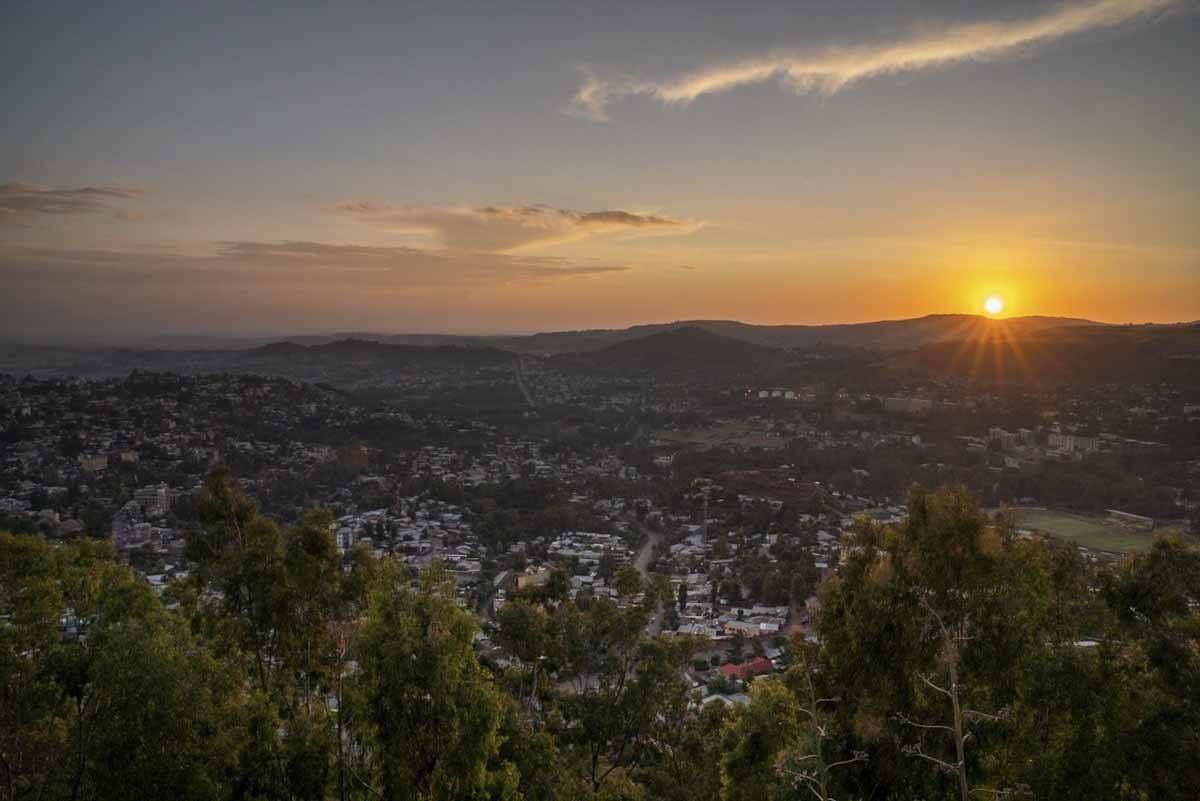
Ethiopian Time and Calendar
Ethiopia has its own calendar, about 7 years behind the international calendar. So, even though I visited Ethiopia in November 2019, it was in fact Ḫədar (ኅዳር), the third month of the year 2012.
The reason is that Ethiopia doesn’t follow the Gregorian calendar like most of the rest of the world, but their own solar calendar, with twelve 30-day months and a thirteenth month made of 5 or 6 days (depending on whether or not it’s a leap year).
Most people in the tourism industry will refer to the international calendar when dealing with tourists, but don’t be fooled into thinking you’ve jumped into a time-warp and emerged 7 years younger if you see the Ethiopian date on entrance tickets or posters around the country.
To make matters even more complicated, Ethiopia also has its own time system! There are two 12-hour cycles, one going from dawn (7 am) to dusk (7 pm), and another from dusk to dawn. So basically, 7 am East Africa time is 1 am Ethiopian time, 8 am is 2, and so on.
I found this out when I asked what time the Stelae Field closed in Axum, and the ticket attendant said ‘at twelve’. It was early afternoon, so I was confused. Did he mean midnight? Or midday the following day? A kind passer-by pointed out that 12 o’clock in Ethiopia is actually 6 – go figure!
If you’re planning to travel around Ethiopia by local bus, always double check whether departure times are given in Ethiopian or regular time. You might find out the hard way otherwise!
I would like to thank the Great Ethiopian Run and Blogilicious for having invited me to Ethiopia. It was a great experience!
